Automated Microscopy Market Research, 2032
The global automated microscopy market was valued at $7.1 billion in 2022, and is projected to reach $13 billion by 2032, growing at a CAGR of 6.4% from 2023 to 2032. The growth of the Automated Microscopy Market Size is driven by surge in adoption of the automated microscope for disease diagnosis and high demand for automated microscope owing to its faster operating as compared to manual microscope. According to a 2022 report by the National Library of Medicine, microscope automation provides a fast and low-cost diagnosis, requiring less supervision.
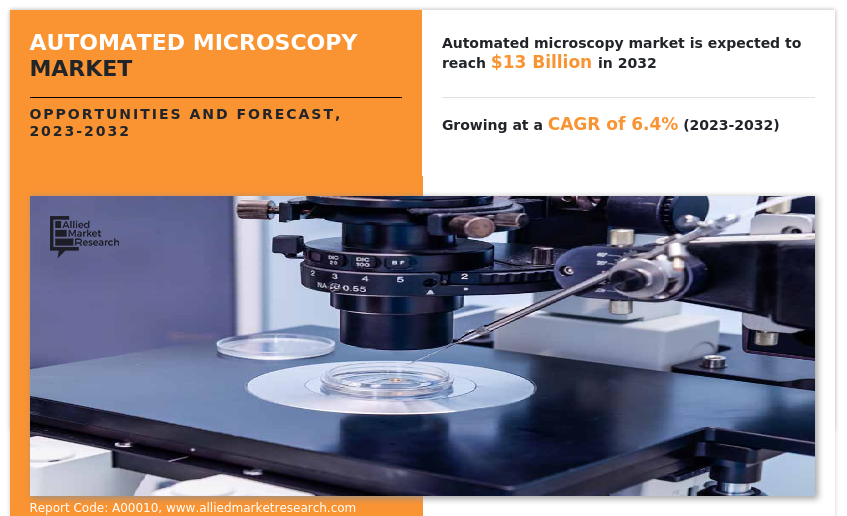
Key Takeaways:
By product, the Optical microscope segment was the highest contributor to the market in 2022.
By application, the Drug discovery and Pharmaceutical segment was the highest contributor to the market in 2022.
By end user, the Pharmaceutical industry segment dominated the market in 2022, and is expected to continue this trend during the forecast period.
By region, North America garnered the largest revenue share in 2022. However, Asia-Pacific is expected to grow at the fastest rate during the forecast period
An automated microscope is a cutting-edge scientific instrument designed to enhance the process of image acquisition. Unlike traditional microscopes that require manual adjustments and image capture, automated microscopes are equipped with advanced technology, including motorized stages, focus controllers, and digital imaging systems. These features enable researchers to precisely control the position, focus, and magnification of the microscope, often with the aid of computer software. The output of an automated microscope typically includes high-resolution digital images or even time-lapse videos of specimens, which can be stored and analyzed for various purposes, such as biological research, and medical diagnostics. Automated microscopes have revolutionized scientific and medical research by streamlining and accelerating the imaging process, allowing for more consistent and detailed observations, and enabling the collection of vast datasets for in-depth analysis and interpretation.
Market Dynamics
The Automated Microscopy Market Size is expected to grow significantly, owing to surge in adoption of the automated microscope for the research in the field of life science, increase in demand of automated microscope for disease diagnosis, and the high preference towards the automated microscope by the researchers.
Automated microscopes have revolutionized the way researchers conduct experiments and investigations in the healthcare sector. Automated microscope offers an unprecedented level of efficiency and precision, allowing scientists to analyze biological samples with greater speed and accuracy. This not only accelerates the pace of research but also ensures more reliable results. Moreover, the integration of advanced imaging technologies and sophisticated software in automated microscopes has significantly expanded their capabilities. Researchers can now conduct complex analyses, such as high-throughput screening, 3D imaging, and time-lapse studies, with relative ease. Furthermore, the increased demand for high-throughput screening and the need for rapid data collection and analysis in fields such as genomics, drug discovery, and cell biology, have made automated microscopes an indispensable tool. These instruments enable researchers to handle large datasets efficiently, facilitating the discovery of novel insights and patterns. Overall, the surge in adoption of automated microscopes has paved the way for groundbreaking discoveries in life sciences, making them an essential component of modern scientific research, and consequently driving the growth of the Automated Microscopy Industry.
Furthermore, the increasing demand for automated microscopes in disease diagnosis has emerged as a major driver propelling the growth of the Automated Microscopy Industry. The automation of microscopy processes has significantly enhanced the accuracy and efficiency of disease diagnosis. Automated microscopes can rapidly analyze large volumes of biological samples with minimal human intervention, reducing the risk of errors and speeding up the diagnostic process. For instance, according to 2022 report by National Library of Medicine, combining automated image acquisition with a suitable artificial intelligence algorithm in the device for diagnosis significantly increases its potential as a diagnostic tool in resource-limited settings.
Additionally, automated microscopes enable healthcare professionals to visualize and study microscopic structures with unprecedented precision, aiding in the early detection of diseases and thereby improving patient outcomes. Furthermore, the advent of artificial intelligence and machine learning in the field of automated microscopy has revolutionized disease diagnosis. These technologies can assist in the automatic identification of pathological features within specimens, enabling healthcare practitioners to make more informed and timely decisions. For instance, Nikon Corporation, a global leader in optical instruments, provides artificial intelligence software that integrates with automated microscopes for more efficient and improved working. Some of the artificial intelligence software provided by Nikon Corporation are Autosignal.ai, Clarify.ai, Convert.ai, Denoise.ai, Enhance.ai, Segment.ai. Thus, the increased demand for automated microscopes in disease diagnosis is expected to drive the growth of the market.
In addition, the automated microscope has garnered significant favor among researchers, emerging as a major driver for the growth of the automated microscope market. Automated microscopes offer unparalleled efficiency and precision in sample analysis. By automating tasks such as focusing, image capture, and data analysis, researchers can significantly reduce human error and enhance the accuracy and reproducibility of their experiments. Moreover, the speed at which these instruments operate allows for the rapid acquisition of large datasets, facilitating high-throughput experimentation. Another crucial advantage is the integration of advanced imaging and analysis software, which enables researchers to extract more detailed information from their samples. This software can assist in tasks like image segmentation, object tracking, and even 3D reconstruction, which are pivotal in various scientific domains. Furthermore, the user-friendly interfaces of automated microscopes make them accessible to a wider range of researchers, reducing the barriers to entry for those without extensive microscopy expertise. Researchers appreciate the convenience of remote monitoring and control, as they can access and analyze their samples from virtually anywhere, fostering collaboration and data sharing. In addition, automated microscopes are pivotal in enabling long-term time-lapse experiments and continuous monitoring, which is crucial in fields such as cell biology. Thus, the growing preference of researchers toward automated microscopes is expected to drive the Automated Microscopy Market Growth.
However, the high cost of automated microscopes stands out as a significant restraint in the market growth. Automated microscopes are equipped with cutting-edge technology, including high-resolution imaging capabilities, motorized stage controls, and intricate software for data analysis. These features make them essential tools in various fields, such as biomedical research, materials science, and forensics. However, their intricate design and specialized components contribute to a substantial price tag. The cost of automated microscopes can range from tens of thousands to even millions of dollars, depending on the model and its specific features. This financial barrier restricts access to these instruments for smaller research institutions, laboratories with limited budgets, and emerging economies, hampering their ability to conduct advanced research and analysis. Furthermore, the ongoing need for maintenance, technical support, and software updates adds to the overall cost of ownership, making automated microscopes a challenging investment for many potential users.
The 2023 global recession poses challenges for the automated microscopy market. Reduced healthcare spending due to budget constraints from governments and research institutes may impact device purchases. Layoffs at medical tech companies, such as Thermo Fisher Scientific and Agilent Technologies, hinder innovation, and high inflation in 2022 raised production costs of automated microscopes.
Segmental Overview
The global automated microscopy market is segmented on the basis of product, application, end user, and region. By product, the market is classified into optical microscope, electron microscope, and scanning probe microscope. By application, the market is categorized into medical diagnosis, life science research and drug discovery and pharmaceutical. By end user, the market is segmented into diagnostic laboratories, research laboratories and pharmaceutical industry. Region-wise, the market is analyzed across North America (the U.S., Canada, and Mexico), Europe (Germany, France, the UK, Italy, Spain, and rest of Europe), Asia-Pacific (Japan, China, Australia, India, South Korea, and rest of Asia-Pacific), and LAMEA (Brazil, South Africa, Saudi Arabia, and rest of LAMEA).
Product Type
The automated microscopy market is categorized into optical microscope, electron microscope and scanning probe microscope. The optical microscope segment dominated the global Automated Microscopy Market Share in 2022 and is anticipated to continue this trend during the Automated Microscopy Market Forecast period. This is attributed to an increasse in demand for mediacal diagnosis and advancement in devices.
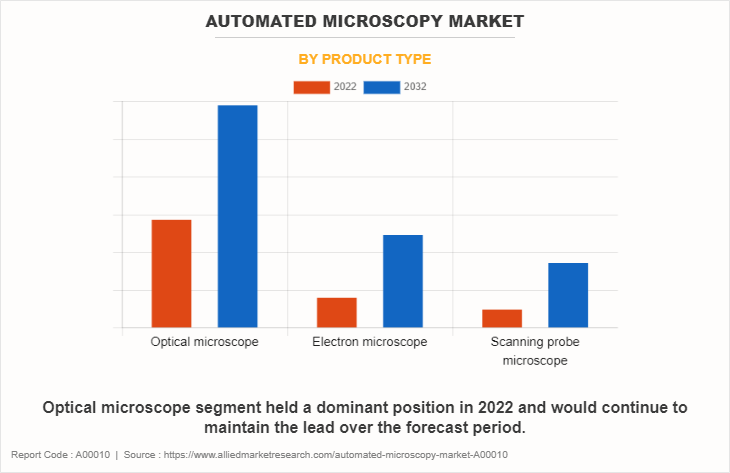
By Application
By application, the market is categorized into medical diagnosis, life science research and Drug discovery and Pharmaceutical. The Drug discovery and Pharmaceutical segment dominated the global Automated Microscopy Market Share in 2022 and is anticipated to continue this trend during the forecast period due to advancements in the automated microscopy and growing demand for drug discovery.
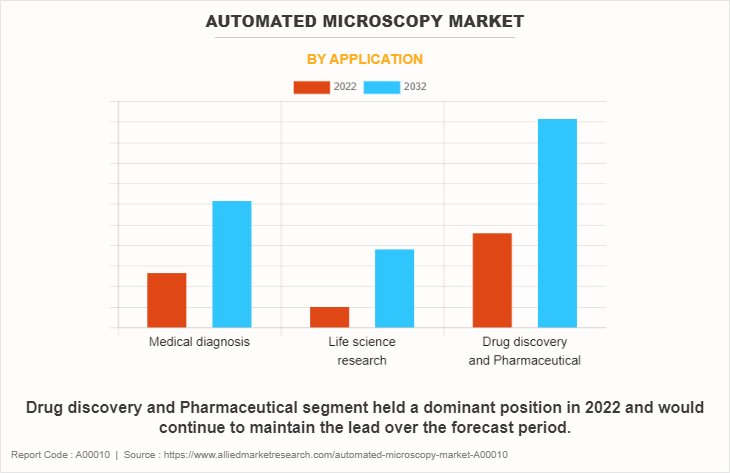
By End User
On the basis of end user, the market is categorized into diagnostic laboratories, research laboratories and pharmaceutical industry. The pharmaceutical industry segment dominated the market in 2022, owing to developments in pharmaceutical industry.
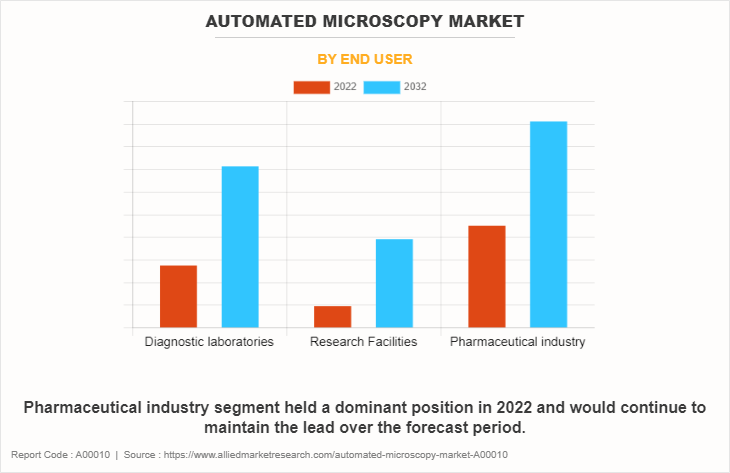
By Region
On the basis of region, the automated microscopy market is analyzed across North America, Europe, Asia-Pacific, and LAMEA. On the basis of region, North America had the highest market share in 2022, owing to increase in demand for automated microscopes for healthcare research, and strong presence of major key players. However, Asia-Pacific is expected to exhibit the fastest growth during the forecast period, owing to rapidly developing pharmaceutical industry and growth in demand for automated microscopes in disease diagnosis.
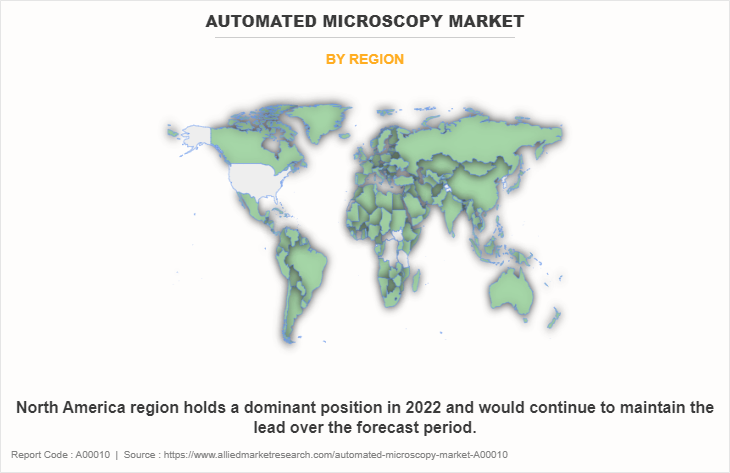
COMPETITION ANALYSIS
Competitive analysis and profiles of the major players in the automated microscopy market, such as Agilent Technologies, Inc., Bruker Corporation, Carl Zeiss AG, Thermo Fisher Scientific Inc., Hitachi, Ltd., Nikon Corporation, Olympus Corporation, Danaher Corporation, Etaluma, Inc., and Horiba Scientific. Major players have adopted product launch as key developmental strategies to improve their product portfolio and gain strong foothold in the automated microscopy market.
Recent product launch in the Automated Microscopy Market
In December 2021, Bruker announced the release of JPK NanoWizard V BioAFM, a novel system that marks a milestone in automation and ease of use for life science atomic force microscopy research. NanoWizard V is a very fast, automated BioAFM that can optionally be fully integrated with advanced optical microscopes. It enables rapid, quantitative mechanical measurements and the analysis of dynamics on samples ranging in size from sub-molecular to cells and tissues.
In August 2022, Thermo Fisher Scientific announced the launch of a new connected and automated microscope, Thermo Scientific Arctis Cryo-Plasma Focused Ion Beam. Cryo-ET has potential for cell biology research, including the study of infectious disease, neurodegenerative disease, and other structural biology applications.
In October 2022, Thermo Fisher Scientific announced the launch of the Glacios 2 Cryo-Transmission Electron Microscope (Cryo-TEM), a powerful microscope with new automation and high-resolution imaging capabilities designed to help cryo-electron microscopy (cryo-EM) researchers of varying experience levels accelerate structure-based drug discovery.
Key Benefits For Stakeholders
- This report provides a quantitative analysis of the market segments, current trends, estimations, and dynamics of the automated microscopy market analysis from 2022 to 2032 to identify the prevailing Automated Microscopy Market Opportunity.
- The market research is offered along with information related to key drivers, restraints, and opportunities.
- Porter's five forces analysis highlights the potency of buyers and suppliers to enable stakeholders make profit-oriented business decisions and strengthen their supplier-buyer network.
- In-depth analysis of the automated microscopy market segmentation assists to determine the prevailing market opportunities.
- Major countries in each region are mapped according to their revenue contribution to the global market.
- Market player positioning facilitates benchmarking and provides a clear understanding of the present position of the market players.
- The report includes the analysis of the regional as well as global automated microscopy market trends, key players, market segments, application areas, and market growth strategies.
Automated Microscopy Market Report Highlights
| Aspects | Details |
| Market Size By 2032 | USD 13 billion |
| Growth Rate | CAGR of 6.4% |
| Forecast period | 2022 - 2032 |
| Report Pages | 210 |
| By Product type |
|
| By Application |
|
| By End User |
|
| By Region |
|
| Key Market Players | Agilent Technologies, Inc., Danaher Corporation, Nikon Corporation., Etaluma, Inc., Olympus Corporation, Horiba Scientific, Bruker Corporation, Carl Zeiss AG, Thermo Fisher Scientific Inc., Hitachi High-Technologies |
Analyst Review
Automated microscopes are advanced scientific instruments designed to capture high-resolution images of specimens, such as biological samples, materials, or other objects, without the need for continuous human intervention. These microscopes are equipped with motorized components and integrated imaging systems that enable automated sample scanning, focusing, and image acquisition.
The global automated microscopy market is divided on the basis of product type, application, end user and region. The report provides information on various product type, including optical microscope electron microscope, and scanning probe microscope. In addition, the study outlines details about different applications such as medical diagnosis, life science research and drug discovery and development. Furthermore, by end user, the market is divided into diagnostic laboratories, research laboratories and pharmaceutical and biotech companies. Moreover, it analyzes the current market trends of automated microscopy across different regions such as North America, Europe, Asia-Pacific, and LAMEA and suggests future growth opportunities. The study includes revenue generated from the sales of automated microscopes. However, the study excludes the revenue generated from post sales services of automated microscope.
The growth drivers, restraints, and opportunities are explained in the report to better understand the market dynamics. This report further highlights key areas of investment. In addition, it includes Porter’s five forces analysis to understand the competitive scenario of the industry and role of each stakeholder. The report features strategies adopted by key market players to maintain their foothold in the market. Furthermore, it highlights the competitive landscape of the key players to increase their market share and sustain intense competition in the industry
The total market value of the automated microscopy Market is $7,102.44 million in 2022.
The forecast period in the report is from 2023 to 2032.
North America is the largest regional market for Automated Microscopy
There are 10 automated microscopy manufacturing companies are profiled in the report.
The top companies that hold the market share in Bruker Corporation, Carl Zeiss AG, Thermo Fisher Scientific Inc., Hitachi, Ltd and Nikon Corporation
The base year for the report is 2022.
Yes, automated microscopy companies are profiled in the report.
Yes, the competitive landscape included in the automated microscopy Market report
Loading Table Of Content...
Loading Research Methodology...


